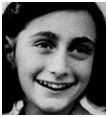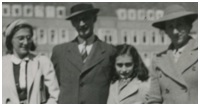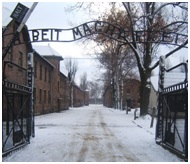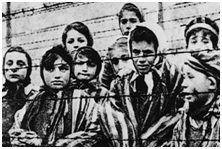|
 |
|
 |
|
|
||
Anne Frank, the Holocaust and Influencing People
Anne Frank and the Holocaust Famous for...
Why the Jews? Adolf Hitler, the leader of Nazi Germany (pictured right), wanted to create a Jewish free Aryan super race. He attacked the Jews in three stages:
1. Ostracization
2. Ghettos Forcing Jews out of their homes into horrible ghettos (Warsaw was the most famous).
3. Extermination (what Hitler called the Final Solution) This final stage led to Jews being murdered in concentration camps.
Nasty Nazis
German leader who described his anti-Jewish (or anti-Semitic) beliefs in his memoirs, Mein Kampf (1925). Adolf Eichmann (pictured right) Responsible for Jewish extermination.
Joseph Goebbels (pictured right) Propaganda chief.
Heinrich Himmler (pictured right) Head of the:
Hermann Göring (pictured right) Head of the Luftwaffe, the German air force.
Josef Mengele (pictured right) The sadistic doctor at Auschwitz who:
Key events
1929 (12th June) Anne Frank born in Frankfurt, Germany. 1933 Adolf Hitler becomes leader of Germany. The Frank family (pictured right in 1941) emigrate to Holland.
1940 Holland surrenders to Nazi Germany.
1941 Hitler orders the Final Solution of Jewish extermination. Auschwitz opens. Dutch Jews (including the Franks) are banned from public places.
1942, 14th June Anne starts her diary (last entry is made on 1st August 1944).
1942, 6th July The Franks go into hiding and are then joined by:
1944, 4th August Anne (and the others in hiding) are:
1944, October Anne and her sister, Margot (pictured right), are taken to another concentration camp, Bergen-Belsen.
1945, March Anne dies a few days after Margot, only weeks before the British would have freed them.
Anne’s secret home She lived above her father’s business in Amsterdam with:
Her front door was hidden behind a bookcase on the second floor, where she lived with:
They were given food and other essentials by four of Otto’s employees including Miep Gies
(pictured right below), who found Anne’s diary after her arrest in 1944.
What happened after Anne’s capture?
1. Auschwitz On arrival at the camp’s railway station in Poland, Anne (and the others in hiding):
But 500 people on their train were gassed and burned – old people, the sick, cripples and small children. The camp’s infamous gateway had the words Arbeit Macht Frei (Work Makes You Free) -pictured right. At least 2 million Jews were killed there and many thousands of others including gypsies and Russian prisoners of war.
2. Bergen-Belsen (survivors are pictured right) Anne and her sister, Margot, died there. Everyone in Anne’s secret home also died, except her father, Otto, who published her diary and died in 1980.
Anne’s day at Auschwitz-Birkenau Woken up at 3.30 am, her living conditions and food were atrocious:
She worked at least 10 hours with constant beatings and at 9 pm tried to sleep in her over crowded, unhygienic hut. Toilet and washing facilities were extremely limited, and the prisoners had to go naked to the bathhouse, even in the freezing cold. Like everybody else, Anne was extremely thin and weak due to starvation and hard labour.
Reasons to remember Anne (6 H’s)
1. The Holocaust Anne is an eternal symbol of the horrible Holocaust. Remembering her is a tribute to the millions who died.
2. Humanity Anne was a lovely human being (kind and forgiving, courageous, clever and charming). She:
But, like everybody else, she had her faults. Anne:
3. Hope Despite the constant terror of capture, she was optimistic about life and human nature, drawing inspiration from:
a) nature She loved the chestnut tree she could see from the attic, where she wrote her diary. b) people (particularly her family and Peter van Pels, pictured right, whom she fell in love with).
c) God Religion gave her:
4. Humour and fun She always believed that life was to be enjoyed, not endured. She saw the funny side of any situation, even dangerous moments like the burglary of the warehouse below her secret home.
5. Heroism She had enormous compassion, courage and character. Anne:
6. Honesty She honestly accepted her strengths and weaknesses. As she became more mature, she also became more honest in her relationship with Peter. She realized that her infatuation couldn’t become true love because of their:
Some other Holocaust heroes
Corrie ten Boom (1892-1983) and her family Encouraged by their Christian faith, the ten Bloom family helped Jews by turning their home into a hiding place So the title of Corrie ten Bloom’s (pictured right) 1971 best-selling autobiography was The Hiding Place.
Oskar Schindler (1908-74) The film, Schindler’s List, shows how Schindler (pictured right) saved hundreds of Jews by employing them in his factory.
Raoul Wallenberg (1912-47) A Swedish diplomat (pictured right) in Budapest, Hungary, who saved thousands of Jews from certain death in concentration camps.
Frank Foley (1884-1958) A British spy (pictured right) working at the British Embassy in Berlin in the 1930’s who saved around 10,000 Jews.
Key quotes from Anne’s dairy
Think of all the beauty that’s still left in and around you and be happy! (7th March 1944).
I want to go on living even after my death! (4th April 1944, talking about the legacy of her writing).
You must work and do good...if you wish to earn happiness (6th July 1944).
A quiet conscience makes one strong! (6th July 1944).
It’s really a wonder that I haven’t dropped all my ideals because they seem so absurd and impossible to carry out. Yet, I keep them, because in spite of everything I still believe that people are really good at heart (15th July 1944).
A person’s character lies in his own hands (15th July 1944).
Other Holocaust quotes
How could it be possible for them to burn people, children and for the world to keep silent?, - Elie Wiesel, Jewish writer and Auschwitz survivor (pictured right) who believed that indifference to evil caused the Holocaust .
If I am not for myself, who will be for me? - Primo Levi ,Jewish writer and Auschwitz survivor (pictured right), on the Jewish need for self-defence and honouring the dead in his poem, Gedale’s Song
People sometimes ask me: where was God in the Holocaust? But the real question is: where was humanity?, - Jonathan Sachs, Britain’s Chief Rabbi 1993-2013, pictured right (explaining that the Holocaust was caused by ignoring God’s teaching of love).
Violence is in the end self-destructive. - one Holocaust survivor on its lessons.
A mother, driven mad, screamed at a British sentry to give her milk for her child, and thrust the tiny mite into his arms, then ran off, crying terribly. He opened the bundle and found the baby had been dead for days, - Richard Dimbleby (BBC journalist, pictured right), describing the British liberation of Bergen-Belsen.
The road to Auschwitz was built with hate but paved with indifference. - Ian Kershaw, pictured right (in his book, Hitler, the Germans and the Final Solution, 2008, about the indifference of the German people towards the Holocaust).
Best Holocaust films
Schindler’s List (based upon Oskar Schindler’s saving of Jews)
The Pianist (the story of the Jewish Polish pianist, Wladyslaw Szpilman, pictured right, who is saved from death by the kindness of a German officer).
|
|
|
||
|
|
||
| Copyright © wisdomtowin.com 2025 All Rights Reserved | ||
|




























